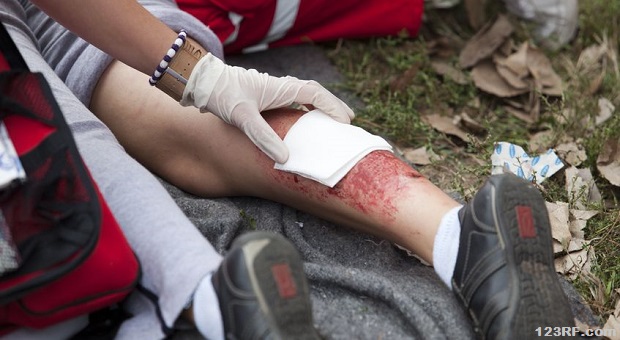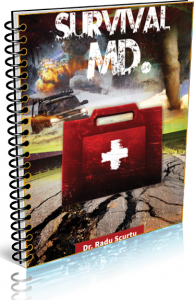In the aftermath of a major crisis there will be a need for people to know how to perform first aid to save lives and to treat minor injuries.
Not so long ago, first aid didn’t go much beyond the “ABC’s” – Airway, Breathing, and Circulation. Today things are far more complicated by everything from drug use to an increased reliance on outpatient care for people that would have been in a hospital as opposed to in a community that is collapsing.
During a crisis, assessing whether or not to move the victim and how to do that job is even more complicated, meaning more care will need to be delivered before you can get help from a medical team. No matter whether you are trying to help one person or dozens, evaluating medical emergencies and treating those that are most life threatening is very important.
What to Do First for the Injured
You can use the following guidelines, but always be aware that field conditions may cause a change in priorities.
- Secure patient from immediate danger. This includes rescue from drowning, electrocution, gunfire, or other situations where it is impossible to deliver lifesaving care.
- Restore breathing and heartbeat if absent.
- Stop any bleeding. There are two ways to control bleeding. The first is by applying direct pressure over the wound and if possible raise the injured area over the heart. The second method is to apply a tourniquet.
- Protect wounds and stabilize fractures or dislocations: The best way to do this is to bandage, splint, and pad the injury.
- Treat for shock: If the injured individual has experienced either interior or exterior bleeding there is a good chance this person will go into shock. To treat raise the legs so as much blood as possible will remain in the torso and not in the legs.
Restore Breathing and Heartbeat
Basic symptoms of blocked airways include loss of consciousness, no noticeable signs of air movement, unable to speak, cough, or make sounds. Victim may also hold their hands to throat to get attention.
Essential skills to help breathing include:
- How to remove obstructions from throat and mouth,
- Clearing obstructions when patient is having a seizure,
- How to reposition airway,
- Clear vomit from mouth and airway during CPR if you use the older standard that includes rescue breathing.
Loss of circulation symptoms include no pulse, blue lips and finger tips. You need to know how to take pulse from wrist or other areas. Never use your thumb to feel for a pulse because you will mistake your own pulse for that of the other person. You also need to know BCLS (Basic Cardiac Life Support) training, and how to use a portable defibrillator
Bleeding and Wound Care
Basic symptoms are deep cuts, punctures, or wounds that spurt bright red blood or a lot of bleeding in general. Internal and external injuries can cause severe bleeding that leads to pale skin, dizziness, clammy/cold skin and shock. Internal bleeding can also cause blood in urine, tarry stools, vomiting, or coughing up blood.
Essential skills that you need refer to
- How to apply pressure bandages and tourniquets,
- How to recognize signs of blood loss and shock,
- Know when it is safe to give salt/sugar/electrolyte fluids,
- Different types of bandaging and dressing,
- How to clean and debride wounds and ulcers,
- How to prevent and/or manage redness, discoloration, wound odor change, soreness, heat, inflammation and other signs of infection,
- How to transport people with internal wounds, keep them comfortable and immobilized as much as possible. Anything more for internal injuries is beyond what you can expect to manage in a crisis situation.
Shock
Circulatory shock is caused either by internal or external bleeding. Basic symptoms are paleness, cold, clammy skin or loss of consciousness. If internal bleeding is suspected also look for blood in the urine, a tarry stool, vomiting or coughing up blood.
Essential skills refer to:
- How and when to raise injured person’s feet to ensure maximum blood supply to torso,
- Treatment for wounds,
- Transport to hospital or doctor for fluids and further care.
Burns
First degree burns is very minor, and only involves the outer most layer of the skin. Skin does not blister, but will feel a burning pain. You need to know how to use herbs or other medication to provide relief from burning.
Second degree burns penetrates down to the second layer of the skin and produces a red blistered surface that is very painful. You need to know how to apply medication and also determine if joints needs special care.
Third degree burns destroys deep tissues sometimes down to the bone. These are serious burns that can leave a charred, black horrifying open wound. Learn how to debride wounds and keep them clean free of infection, in order to provide first aid to the injured.
Hot Temperature Injuries
One basic symptom is dehydration: at the beginning, the individual may sweat heavily and then stop even though exertion continues. Also, cramps from losing body salt, thirst, dry tongue, dizziness, and a feeling of sickness are also common symptoms. Ironically, thirst is not always an indicator of dehydration in the later stages.
In order to help the injured, learn how to provide safe, clean water with electrolytes in a way that does not cause vomiting or other problems. Also, you need to know how to reduce body temperature without using medications.
Heat exhaustion includes all of the symptoms of dehydration with acute headaches, pale clammy skin, dizziness, tired, nausea, and dark urine. What you need is to know how to reduce body temperature and how to get liquids and electrolytes into the body and absorbed.
In case of heatstroke, body temperature rises out of its normal temperature (97.8 to 100.4). Heatstroke symptoms are similar to those of heat exhaustion but are more severe with shallow breathing, rapid weak pulse, confusion, hot, dry skin, or going in and out of consciousness.
Skills that you need for first aid are how to reduce body temperature and how to get liquids and electrolytes into the body and absorbed. Also, you have to deal with mental confusion and loss of consciousness of the injured.
Treatment of Cold Weather Injuries
There are a few types of cold weather injuries, and also essential skills that you need in order to provide first aid to your injured fellow.
Trench foot: This can happen when feet are wet for long periods of time. The feet go pale and clammy before turning red and swollen. What you need to do is to warm feet up in stages to reduce chance of tissue damage.
Frostbite: The body is literally freezing. The most vulnerable parts of the body are the hands and feet and other parts that are exposed to the weather like your nose and ears. Symptoms include the feeling of pins and needles progressing to numbness.
The skin turns white and cold before turning blue with blisters. The worst sign of frostbite is when the effected part turns black and hard. You need to know how to warm up exposed area slowly and assess for circulatory damage.
Hypothermia: Hypothermia is when the body core drops below 95 degrees f. Early symptoms include mood swings, an inability to concentrate, and clumsiness.
As the symptoms continue to develop drowsiness, shallow breathing, slowing heart rate, followed by unconsciousness and death. What you need is to change clothes to get rid of wet ones, and also to raise body core temperature using warm compresses.
Poisoning
In case of ingested materials, the symptoms are stomach ache, diarrhea, or throwing up, sleepy, confused, mental distress, and there may also be burn marks around or in the mouth.
The first thing to do is to identify poison substance, and then determine which treatment to apply (ex. charcoal). If possible, call poison control center or read labels on bottles you suspect contained the poisoning agent.
When the substance is inhaled, look for pale skin, light blue finger tips and lips, smell of chemicals on the breath or around face, mental impairment and confusion. Get as much fresh air as possible to help the injured is the first thing to do.
Symptoms for skin irritants or chemical poisoning of the skin there could be redness, swelling, and blisters at the contact site. You need to know how to flush skin and eyes with water or other solutions.
In case of injected poisons, loss of breathing, confusion, erratic heartbeat, nausea, loss of motor coordination, sweating will appear. Identify poison agent, learn how to keep heart and lungs functioning, and how to reverse poison agent.
Fractures and Dislocations
It is important to stabilize all fractures and dislocations to keep them from causing more physical damage to the injury site.
Fracture in a limb are great pain at the fracture site, bad bruising, limb deformity, or a piece of bone protruding through the skin. Skills that you need to provide first aid are how to pull bones to re-align fracture point, and how to set a splint.
Signs of a dislocation are a joint that is displaced from its normal placement, swelling of the joint, and severe pain in the joint. You need to know how to restore normal joint placement, and how to immobilize joint.
Drug Abuse
Symptoms for drug abuse are tremors, shakes, vomiting, diarrhea, and uncontrollable sweating. With the mental side of the problem comes paranoia, depression, hallucinations just to name a few.
You need to know how to restrain patient, and then address physical, mental, and emotional symptoms with supportive care.
Electrocution
The symptoms are burning odor, lack of motor coordination, bleeding from nose or eyes, convulsions.
Learn how to disconnect victim from electric source without becoming part of the circuit, restore heart and lung function, address burns and other external damage, and transport to facility for internal organ damage treatment.
Drowning
The symptoms include arms clasped tightly at side, unable to remain buoyant, under water for several seconds, unable to speak or signal for help, floating face down, head tilted back, and not making progress while swimming.
You need to know how to use other devices to get person out of the water without going in yourself. Learn how to look for the fastest way to get to the person and get them out of the water given scenario, and how to throw a life line or other aide if person is conscious and able to grab it. Another basic skills for providing first aid is to administer CPR and clear airway of water.
PTSD and Mental Disorders
The symptoms are hallucinations, flashbacks, nightmares, disorientation, paranoia, mental or emotional numbness, and frozen actions, or other symptoms of mental or emotional distress.
What you need to know is to determine if someone is having a mental episode, and how to restrain person and talk to them to bring them out of the episode.
Pain Management
Basic symptoms when pain management is needed include radiating or non-radiating waves of pain in just about any area of the body.
You could provide help if you learned how to use acupressure, Reiki, reflexology, and other non-drug based pain relief methods. Also, you should know about herb based topical and ingestible pain killers.
End of Life Care
This is probably the worst scenario that one can handle when helping a fellow, and sometimes it’s not much you can do to avoid the final act, as his body is shutting down with no hope of healing or recovery.
What you can do is pain management, and deliver comfort care such as toileting, feeding, temperature stabilization, social company, attend spiritual matters and last requests if possible.
Where to Get Training
As you read through this list, you may be inclined to think several of these areas do not belong in the category of immediate first aid. Consider that after a collapse, it may take hours for an ambulance to arrive, or days on end before you can get to a doctor or into a hospital for treatment.
It will be more than worthwhile to extend your medical knowledge past conventional first aid so that you can handle a wider range of situations if needed.
Aside from first aid training offered by the Red Cross and other organizations, you may want to look into the following:
- Basic Cardiac Life Support training – There is a program offered by the American Heart Association as well as the more robust Red Cross Program.
- CNA training. Some communities and nursing homes offer this training for free. You will learn everything from how to manage patients to detecting a number of different problems.
- Hospice volunteer training. This is usually offered for free. Hospice offers the most information on pain management and comfort when no treatment options are left.
- Reiki and accupressure, and reflexology are not fully recognized in conventional medicine, but accupressure and reflexology have been used in China and other cultures for decades. Alternative healing classes are available in most areas for a wide range of fees.
- Al-Anon or support groups for drug addiction. Even if you are not addicted to drugs or you are not an alcoholic, it is important to know how to deal with people that have these problems. In a post collapse situation, those who are addicted to illegal, prescription or other drugs are going to be in worse shape because their drug of choice will not be available. Recognizing the signs of addiction and being able to talk effectively to that person or subdue them can make the difference between life and death for everyone involved.
Even if you have a set of basic first aid skills, taking the time now to study these areas will make it easier to survive in the field. You can start by updating your first aid manual, and then make a list of things you have never studied or gotten training for.
Be prepared to spend months or even years acquiring all the necessary skills and equipment. If there are parts you truly can’t manage, at least make sure someone else in your survival group can handle these things and gets proper training.
Disclaimer: This guide is intended to give you some ideas about first aid and medical skills that will give you the best chance of surviving a crisis scenario, and is not supposed to stand for professional medical advice. As with many other aspects, the more information, training and equipment you get from quality sources, the better chance you have of surviving a crisis. It is not our intention to take the place of these sources, but to point you in their direction and make you aware of some skills that may be of help based on author’s own experience with a range of situations.
This article has been written by Fred Tyrell for Survivopedia.com
About Fred Tyrell
Fred Tyrrell is an Eagle Scout and retired police officer that loves to hunt, fish, hike, and camp with good friends and family. He is also a champion marksman (rifle, pistol, shotgun) and has direct experience with all of the major gun brands and their clones. Fred refers to himself as a “southern gentleman” – the last of a dying way. He believes a man’s word is his bond, and looks forward to teaching others what he has learned over the years. You can send Fred a message at fred.tyrell [at] survivopedia.com.





